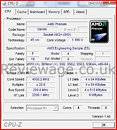- Joined
- Oct 9, 2007
- Messages
- 47,847 (7.39/day)
- Location
- Dublin, Ireland
| System Name | RBMK-1000 |
|---|---|
| Processor | AMD Ryzen 7 5700G |
| Motherboard | Gigabyte B550 AORUS Elite V2 |
| Cooling | DeepCool Gammax L240 V2 |
| Memory | 2x 16GB DDR4-3200 |
| Video Card(s) | Galax RTX 4070 Ti EX |
| Storage | Samsung 990 1TB |
| Display(s) | BenQ 1440p 60 Hz 27-inch |
| Case | Corsair Carbide 100R |
| Audio Device(s) | ASUS SupremeFX S1220A |
| Power Supply | Cooler Master MWE Gold 650W |
| Mouse | ASUS ROG Strix Impact |
| Keyboard | Gamdias Hermes E2 |
| Software | Windows 11 Pro |
The transition of the K10 architecture by AMD to the 45nm silicon fabrication process is stirring up interesting revelations these days. First, it was about surprisingly low power consumption of the quad-core Phenom parts, and then about the overclocking headroom those 45nm parts provided, at least the engineering samples did so far. And now, news coming in that AMD could be resurrecting the "FX" series of extreme performance products. Over the past three or so years, the performance trail AMD products had over Intel's made it close to impossible for AMD to sell parts that provide performance tuning advantages such as unlocked FSB multiplier settings for a premium, like it did back when K8 reigned the performance segment. "Black Edition" chips made up for that deficit by providing consumers overclocking advantages while not charging a significant premium and at the same time, safeguarding the "FX" title, not letting it dilute.
Come AMD Deneb core and lot seems to be on offer. To begin with, unlike the Windsor core that had a maximum FSB multiplier of 16.0x, initial reports suggest the Deneb to sport a maximum 25.0x multiplier, 200 MHz x 25 = 5.00 GHz, with the FSB left to play with. Considering at 2.30 GHz the Deneb draws in 57.3 W (according to findings), it should still leave enough room for AMD to sell premium products clocked at high frequencies.

From Reviewage's findings, there seem to be two Phenom FX processors in the making. The numbering seems to take off where it last left at the Athlon64 FX 74. The two chips, Phenom FX 80 and Phenom FX 82 could be clocked at 4.00 GHz and 4.40 GHz respectively (stock speeds). An interesting statement is that at 4.00 GHz, the Phenom FX 80 should outperform an Intel Kentsfield core clocked at 5.00 GHz, implies it has to be faster than the Kentsfield on a clock-to-clock basis. This opens up an interesting debate on how these parts compare to the succeeding Yorkfield chips. This should also open gates for several models to enter the market at various clock speeds.
View at TechPowerUp Main Site
Come AMD Deneb core and lot seems to be on offer. To begin with, unlike the Windsor core that had a maximum FSB multiplier of 16.0x, initial reports suggest the Deneb to sport a maximum 25.0x multiplier, 200 MHz x 25 = 5.00 GHz, with the FSB left to play with. Considering at 2.30 GHz the Deneb draws in 57.3 W (according to findings), it should still leave enough room for AMD to sell premium products clocked at high frequencies.

From Reviewage's findings, there seem to be two Phenom FX processors in the making. The numbering seems to take off where it last left at the Athlon64 FX 74. The two chips, Phenom FX 80 and Phenom FX 82 could be clocked at 4.00 GHz and 4.40 GHz respectively (stock speeds). An interesting statement is that at 4.00 GHz, the Phenom FX 80 should outperform an Intel Kentsfield core clocked at 5.00 GHz, implies it has to be faster than the Kentsfield on a clock-to-clock basis. This opens up an interesting debate on how these parts compare to the succeeding Yorkfield chips. This should also open gates for several models to enter the market at various clock speeds.
View at TechPowerUp Main Site
Last edited:








 Hopefully there not that expensive. This is good news for us non OCers to.
Hopefully there not that expensive. This is good news for us non OCers to.